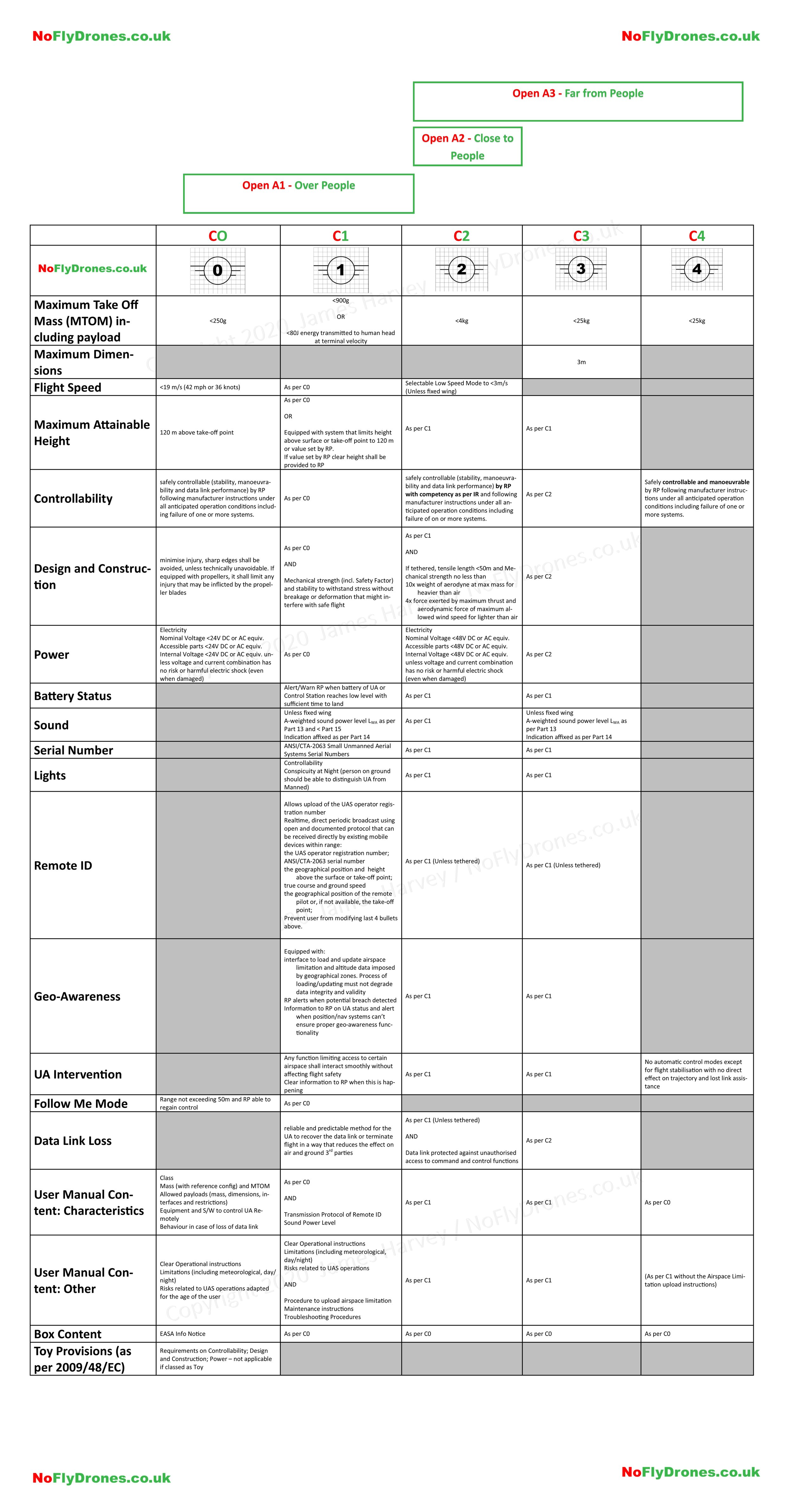Weight / Dimension / Speed / Height
The Maximum Take-Off Mass must be no more than 4kg.
There is no maximum size specified for this type of drone.
There is no maximum speed but the drone must be fitted with a selectable low speed mode (unless fixed wing).
The maximum attainable Height 120 m above the take-off point OR the height can be user selectable in relation to the TO point or surface of the earth but this must display data to RP about current height.
Controllability / Design / Power / Battery Alerting
The drone will need to be safely controllable in stability, maneuverability, and data link performance by an RP with competency (as per the Implemented Regulation) and under all anticipated operating conditions including failure of one or more systems.
The drone will need to be designed and constructed to minimise injury, minimising sharp edges and if equipped with propellers, limit injury that may be inflicted by them.
The drone must have the mechanical strength (incl. Safety Factor) and stability to withstand stress without breakage or deformation that might interfere with safe flight.
If tethered, the tensile length must be <50m and have the mechanical strength no less than 10x weight of aerodyne at max mass for heavier than air or 4x force exerted by maximum thrust and aerodynamic force of maximum allowed wind speed for lighter than air.
The drone will need to be powered by electricity with all voltages (Nominal, Accessible, Internal) <48V DC or AC Equiv. Internally this can be more if the voltage and the current combination has no risk and no harmful electric shock (even when damaged)
The drone must alert the RP when battery of Drone or Control station is low, this must give sufficient time to land.
Noise Emissions / Serial ID / Lighting
Unless fixed wing, it must have an A-weighted sound power level LWA (measured as per Part 13 of Delegated Regulation). The level should be limited (as defined in Part 15 of Delegated Regulation - note this gets more stringent with time). The sound power level indication shall be affixed (as per Part 14 of Delegated Regulation)
The drone shall have a serial number as per the standard - ANSI/CTA-2063 Small Unmanned Aerial Systems Serial Numbers
Lights wll need to be fitted for Controllability and Conspicuity at Night (person on ground should be able to distinguish UA from Manned). From the 1st July 2022 a green flashing light must be activated when flying at night.
Remote ID
The drone shall be equipped with Remote ID that allows upload of the UAS operator registration number.
The Remote ID shall work in realtime and with direct periodic broadcast (using open and documented protocol that can be received directly by existing mobile devices within range) the following:
the UAS operator registration number;
ANSI/CTA-2063 serial number
the geographical position and height above the surface or take-off point;
true course and ground speed
the geographical position of the remote pilot or, if not available, the take-off point;
It shall also prevent user from modifying last 4 bullets above.
There is no requirement for Remote ID if the drone is tethered.
Geo-Awareness
The drone shall have Geo-Awareness which shall be equipped with
an interface to load and update airspace limitation and altitude data imposed by geographical zones. Process of loading/updating must not degrade data integrity and validity
RP alerts when potential breach detected
Information to RP on UA status and alert when position/nav systems can’t ensure proper geo-awareness functionality
System Intervention and Follow-Me
Any function limiting access to certain airspace shall interact smoothly without affecting flight safety and this shall provide clear information to the RP when this is happening
Follow-me mode shall not exceed 50m and shall allow RP to regain control
Data Link Failure Behaviour
The drone shall have a reliable and predictable method for the UA to recover the data link or terminate flight in a way that reduces the effect on air and ground 3rd parties
Data link shall be protected against unauthorised access to command and control functions.
User Manual and Box Content
The User Manual shall clearly identify:
Class
Mass (with reference config) and MTOM
Allowed payloads (mass, dimensions, interfaces and restrictions)
Equipment and S/W to control UA Remotely
Behavior in case of loss of data link
Clear Operational instructions
Limitations (including meteorological, day/night)
Risks related to UAS operation
Transmission Protocol of Remote ID
Sound Power Level
Procedure to upload airspace limitation
Maintenance instructions
Troubleshooting Procedures
The box shall contain an EASA Info Notice detailing laws etc. applicable to the drone.
Based on the above my interpretation is that these drones are going to be slightly bigger, in today’s world this might be a DJI Phantom. However it’s important to know that drones placed on the market prior to these regulations can’t be claimed to fall into any of these Classes. They fall under a different set of rules that have been set up to cover the use of legacy drones.












